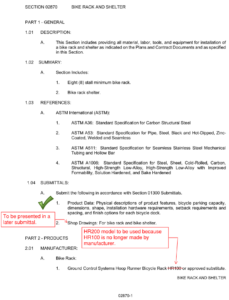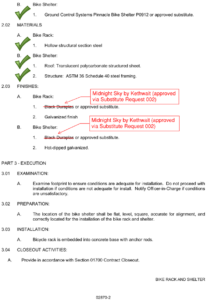Executive Summary. Making submittals on a construction project is art and science. Increase your success rate on submittals using this method! Check, check, check!
What’s a submittal in construction? Buildings, dams, roads, et cetera, are all built using materials like concrete, aggregate, tile, paint, overhead cranes, toilets, and electrical wire. But, it’s not as simple as just ordering the material and installing it. Many owners, especially public owners, require that each of these materials be approved via a “submittal” before it is put in place on the project.
A submittal is a document package which explains on paper (or digitally) what is going to be installed. The engineer or architect can then see in this submittal package from the Contractor whether or not the material proposed satisfies the design intent and the Contract Documents.
Be the engineer. The submittal you’re making has to satisfy the specification. And, here’s news – the review of a submittal is not rocket science. Engineers are busy people and all they’re going to do when you make a submittal is open up the specification and make sure the material meets or exceeds what’s required of the project. They will take the specification and check each paragraph to ensure that the material is good. Although some contracts require it, you might as well simply take out the specification yourself and do the Engineer’s work: check each paragraph in the specification that is met and those that aren’t met, simply state the deviation. The engineer is likely going to check your work to keep you honest, but if you can assist with this review it can take days off the return time and it can build up credibility between Contractor and Engineer.

Give me an example. As an example, let’s take a bike rack and shelter submittal. In paragraph 1.04 of the Project Specification 02870 from our job, there are two submittals required: product data and shop drawings. We’re going to make the product data submittal.
There will be three main parts of the submittal: the cover sheet, the specification accompaniment, and the actual product data. The cover sheet is something you will make from your computer with your company’s logo on it. The product data is the actual manufacturer’s or supplier’s literature explaining their product. The specification accompaniment is the new trick you’re learning today.
The specification accompaniment is the excerpt from the specification which lists the product requirements. You as the submittal preparer simply markup with simple checkmarks and notes of deviation what your proposed product complies with, or doesn’t.
So, here we go with an example. This would be the “checked off” specification accompaniment in your submittal package:


Assume the Engineer knows nothing. You are the Contractor and you know your work. The Engineer knows his or her work. I make these statements because when you markup these specifications, you should assume the Engineer is not up to speed on the construction materials industry and why your submittal is so heavy in deviations:
- Do not assume that he knows that stainless steel isn’t available because of a Ukraine conflict and this is why you’re submitting on fiberglass.
- Do not assume she knows that Alabama is where ductile iron pipe is made and a hurricane just took out the largest manufacturing plants and this is why you’re submitting on PVC pipe.
You have to explain these things and treat them like they know nothing (but, respectfully). If anything, overcommunicate!

My story. A lot of engineers are consultants. This means that they do a lot of jobs at one time. They juggle a lot. And you may be on one project only. My point is that by the time they come up to speed on your job, he or she may have lost an hour or two. The quicker they get up to speed on your submittal, the quicker they can answer. So, if you “do their job for them”, it is good for you and your project. If you’re of the mindset of “to heck with you Scott, I’m not doing their job”, my response is “well, you wanna be right, or you want a submittal back quickly?!”
Check, check, check!
Work safe!






0 Comments